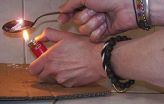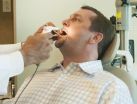(Press-News.org) In a finding that runs counter to most health disparities research, Johns Hopkins researchers say that while younger black trauma patients are significantly more likely than whites to die from their injuries, black trauma patients over the age of 65 are 20 percent less likely to do so.
A report on the research appears online May 28 in JAMA Surgery.
"We have long found it vexing that minority patients consistently do worse, even in treatment for trauma that seems to leave little room for bias," says study leader Adil Haider, M.D., M.P.H., an associate professor of surgery at the Johns Hopkins University School of Medicine. "And although we still see the disparity in younger black patients, we were surprised to find in this study that older black trauma patients were more likely to survive their injuries."
Haider speculates that one reason is that all patients over 65 have better access to health care because of Medicare eligibility, providing access to care that may "level the playing field." Another possibility is that black patients have worse expected outcomes from diseases and trauma throughout life, creating a "healthy survivor bias" as they age.
"There are well-documented disparities in access to health care for younger black patients, so it is possible that black patients who make it to age 65 have potentially reached that age stronger and healthier than their white counterparts of a similar age," says Johns Hopkins surgical resident Caitlin W. Hicks, M.D., M.S., a member of the research team. "This is an important finding in racial disparities research that we need to look into and learn from."
Racial disparities in trauma have always confounded researchers, who assumed that in an emergency situation, all patients would be treated the same, so outcomes wouldn't vary by race. But that has not been the case.
The Johns Hopkins team analyzed in-hospital death rates covering nearly 1.1 million trauma patients in the Nationwide Inpatient Sample for the period between Jan. 1, 2003, and Dec. 30, 2010. Roughly half of the group was between the ages of 16 and 64. In the younger group, racial disparities in survival after trauma conformed to what most other studies have found, namely that black patients were 20 percent more likely to die than white patients. Over the age of 65, the pattern was reversed, with white patients 20 percent more likely to die than black patients. The group used three different statistical models controlling for other illnesses the older patients may have when they are admitted after trauma. All three drew the same conclusions.
The older and younger groups were different in other ways as well, Haider says. The vast majority of patients 65 and older (99.4 percent) had insurance, many of them through Medicare. Also, the vast majority of patients in the older group suffered blunt trauma — car accidents and falls, primarily — as opposed to many more cases of penetrating trauma — gunshot or stab wounds — in the younger age group.
At the outset of the research, Haider, who directs the Center for Surgical Trials and Outcomes Research at Johns Hopkins, says he thought that given the high percentage of insured patients 65 and older, black and white patients would either have similar outcomes, or black patients would continue to have worse outcomes.
"These findings surprised us," he says.
Haider says his team plans to see whether the type of hospital where patients are treated — be it a hospital that treats mostly whites or mostly minorities — has an impact on trauma outcomes for patients 65 and older. Previous research by Haider and his team found that nearly 80 percent of trauma centers in the United States that serve predominantly minority patients have higher-than-expected death rates.
The group has also reported that trauma patients of all races are 40 percent less likely to die — regardless of the severity of their injuries — if they are treated at hospitals with lower-than-expected mortality rates, the vast majority of which serve predominantly white patients.
INFORMATION:
Other Johns Hopkins researchers involved in the study include Zain G. Hashmi, M.B.B.S.; Catherine Velopulos, M.D.; David T. Efron, M.D.; Eric B. Schneider, Ph.D.; and Elliott R. Haut, M.D.
The research was supported by a grant from the National Institutes of Health's National Institute of General Medical Sciences (K23GM093112-01) and the American College of Surgeons C. James Carrico, M.D., F.A.C.S., Faculty Research Fellowship for the Study of Trauma and Critical Care.
Black trauma patients 65 and older more likely to survive than white counterparts
Results run counter to most studies comparing outcomes for blacks and whites
2014-05-28
ELSE PRESS RELEASES FROM THIS DATE:
Demographic of heroin users change in past 50 years
2014-05-28
Bottom Line: Heroin users nowadays are predominantly white men and women in their late 20s living outside large urban areas who were first introduced to opioids through prescription drugs compared to the 1960s when heroin users tended to be young urban men whose opioid abuse started with heroin.
Authors: Theodore J. Cicero, Ph.D., of Washington University, St. Louis, and colleagues.
Background: Few studies on the demographics of present day heroin users have compared them to heroin users 40 to 50 years ago who were primarily young men from minority groups living ...
Study examines risk factors for sagging eyelids
2014-05-28
Bottom Line:
Other than aging, risk factors for sagging eyelids include being a man, having lighter skin color and having a higher body mass index (BMI).
Author:
Leonie C. Jacobs, M.D., Erasmus Medical Center, Rotterdam, the Netherlands, and colleagues.
Background:
Sagging eyelids because of excess skin (dermatochalasis) is typically seen in middle-age or older adults. Typically a cosmetic concern, sagging eyelids also can cause visual field loss, irritation and headaches because patients force themselves to elevate their brow in order to see better.
How ...
Survival after trauma related to race, age
2014-05-28
Bottom Line:
Race and age affect trauma outcomes in older and younger patients.
Author:
Caitlin W. Hicks, M.D., M.S., of the Johns Hopkins School of Medicine, Baltimore.
Background:
Disparities in survival after traumatic injury among minority and uninsured patients has been well described for younger patients. But information is lacking on the effect of race on trauma outcomes for older patients.
How the Study Was Conducted:
The authors examined in-hospital mortality after trauma for black and white patients between the ages of 16 and 64 years and 65 ...
Drug users switch to heroin because it's cheap, easy to get
2014-05-28
A nationwide survey indicates that heroin users are attracted to the drug not only for the "high" but because it is less expensive and easier to get than prescription painkillers.
Researchers at Washington University School of Medicine in St. Louis published the survey's results May 28 in the journal JAMA Psychiatry.
"In the past, heroin was a drug that introduced people to narcotics," said principal investigator Theodore J. Cicero, PhD. "But what we're seeing now is that most people using heroin begin with prescription painkillers such as OxyContin, Percocet or Vicodin, ...
The brain's reaction to male odor shifts at puberty in children with gender dysphoria
2014-05-28
The brains of children with gender dysphoria react to androstadienone, a musky-smelling steroid produced by men, in a way typical of their biological sex, but after puberty according to their experienced gender, finds a study for the first time in the open-access journal Frontiers in Endocrinology.
Around puberty, the testes of men start to produce androstadienone, a breakdown product of testosterone. Men release it in their sweat, especially from the armpits. Its only known function is to work like a pheromone: when women smell androstadienone, their mood tends to improve, ...
Mount Sinai researchers lead committee to define the clinical course of multiple sclerosis
2014-05-28
(NEW YORK – May 28) Accurate clinical course descriptions (phenotypes) of multiple sclerosis (MS) are important for communication, prognostication, design and recruitment for clinical trials, and treatment decision-making. Researchers at Icahn School of Medicine at Mount Sinai, part of the International Committee on Clinical Trials of MS, collaborated to re-examine the standardized MS clinical course descriptions originally published in 1996 and recommend refined phenotype descriptions that include improved clinical descriptive terminology, MRI and other imaging techniques, ...
NASA IceBridge concludes Arctic field campaign
2014-05-28
Researchers with NASA's Operation IceBridge have completed another successful Arctic field campaign. On May 23, NASA's P-3 research aircraft left Thule Air Base, Greenland, and returned to Wallops Flight Facility in Virginia marking the end of 11 weeks of polar research.
During this campaign, researchers collected data on Arctic sea and land ice – both repeating measurements on rapidly changing areas and expanding coverage into new, unsurveyed regions. The mission also released two sea ice data products and provided a professional development opportunity for three science ...
International collaboration highlights new mechanism explaining how cancer cells spread
2014-05-28
DALLAS – May 28, 2014 – UT Southwestern Medical Center cancer researchers have identified a protein critical to the spread of deadly cancer cells and determined how it works, paving the way for potential use in diagnosis and eventually possible therapeutic drugs to halt or slow the spread of cancer.
The protein, Aiolos, is produced by normal blood cells but commits a kind of "identity theft" of blood cells when expressed by cancer cells, allowing the latter to metastasize, or spread, to other parts of the body. Metastatic cancer cells have the ability to break free from ...
Suspect strep throat? Re-check negative rapid test results with lab culture
2014-05-28
Clinical guidelines conflict on testing teens and adults whose symptoms point to a possible strep throat. A chief contention is whether negative tests results from a rapid analysis of a throat swab, done in a doctor's office, should be confirmed through a follow-up laboratory culture.
The rapid test detects certain antigens, one of the body's efforts to fight off strep bacteria. Attempting to grow bacteria from a throat specimen double checks for the presence or absence of Group A Streptococcus bacteria, as well as a few other bacterial infections.
A study published ...
Negative social interactions increase hypertension risk in older adults
2014-05-28
PITTSBURGH—Keeping your friends close and your enemies closer may not be the best advice if you are 50 or older.
New research from Carnegie Mellon University's Rodlescia Sneed and Sheldon Cohen shows that unpleasant or demanding interpersonal encounters increase hypertension risk among older adults.
Published in the American Psychological Association's journal Health Psychology, the study provides some of the first concrete evidence that negative social interactions not only influence psychological well-being but also physical health – in this case, blood pressure ...
LAST 30 PRESS RELEASES:
Penn researchers awarded $25M to conduct trial using smartphones to fight heart disease
PCORI awards funding for new patient-centered healthcare research
Exploring the origins of the universe: 145 low-noise amplifiers complete ALMA telescopes
Empress cicada wings help illuminate molecular structure
Using sound waves to detect helium
Time burden in patients with metastatic breast and ovarian cancer from clinic and home demands
Researchers discover bias in AI models that analyze pathology samples
Scientists ID potential way to prevent brain injuries from triggering Alzheimer's
MASTER 2nd Open Call: Execution period kick-off
Algae for health in food and pharma
Advanced microrobots driven by acoustic and magnetic fields for biomedical applications
Chicago health information leader recognized for raising CPR readiness and blood pressure awareness
The Intimate Animal, a new book from Kinsey Institute Executive Director Dr. Justin Garcia
When blue-collar workers lose union protection, they try self-employment
New video dataset to advance AI for health care
MEA-based graph deviation network for early autism syndrome signatures in human forebrain organoids
New modeling approach sheds light on rare gut disease
Study documents potentially hazardous flame retardants in firefighter gear
Can certain bacteria regulate aging of the immune system and its related alterations?
AI model helps diagnose often undetected heart disease from simple EKG
There are fewer online trolls than people think
Cell membrane fluctuations produce electricity
Jeonbuk National University study shows positive parenting can protect adolescents against self-harm
Surface-engineered ZnO nanocrystals to tackle perfluoroalkyl substance contamination
This new understanding of T cell receptors may improve cancer immunotherapies
A new fossil face sheds light on early migrations of ancient human ancestor
A new immunotherapy approach could work for many types of cancer
A new way to diagnose deadly lung infections and save lives
40 percent of MRI signals do not correspond to actual brain activity
How brain-inspired algorithms could drive down AI energy costs
[Press-News.org] Black trauma patients 65 and older more likely to survive than white counterpartsResults run counter to most studies comparing outcomes for blacks and whites



